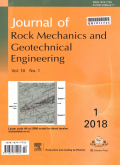- 钛学术文献服务平台 \
- 学术期刊 \
- 基础科学期刊 \
- 天文学、地球科学期刊 \
- 岩石力学与岩土工程学报(英文版)期刊 \
Laboratory large-scale pullout investigation of a new reinforcement of composite geosynthetic strip
Laboratory large-scale pullout investigation of a new reinforcement of composite geosynthetic strip
基本信息来源于合作网站,原文需代理用户跳转至来源网站获取
摘要:
In this paper, more than 70 large-scale pullout tests were performed to evaluate the performance of an innovative composite geosynthetic strip (CGS) reinforcement in sandy backfill. The CGS reinforcement is composed of a geosynthetic strip (GS) and parts of a scrap truck tire as transverse members. The experimental pullout results for the CGS reinforcement were compared with the suggested theoretical equations and ordinary reinforcements, including the GS, the steel strip (SS), and the steel strip with rib (SSR). The pullout test results show that adding three transverse members to the GS reinforcement (CGS3) with S/H=6.6 (where S and H are the space and height of the transverse members, respectively) increases pullout resistance by more than 120%, 170%, and 50% compared to the GS, the SS, and the SSR, respectively. This result shows that the CGS3 (CGS with three transverse members) reinforcement needs at least 55.5%, 63%, and 33.3% smaller length compared to the GS, the SS, and the SSR, respectively. In general, implementation of mechanically stabilized earth wall (MSEW) with the proposed strip may help geotechnical engineers prevent costly designs and solve the problem of MSEW implementation in cases where there are limitations of space.

推荐文章
Protection of Large-scale Wind Power Integration
风力发电
常规保护
一体化
电力电子器件
风力涡轮机
电力系统
波动特性
仿真结果
Distribution and partitioning of heavy metals in large anthropogenically impacted river, the Pearl R
Pearl River
Water and sediment
Heavy metals
Partitioning
Distribution
内容分析
关键词云
关键词热度
相关文献总数
(/次)
(/年)
文献信息
| 篇名 | Laboratory large-scale pullout investigation of a new reinforcement of composite geosynthetic strip | ||
| 来源期刊 | 岩石力学与岩土工程学报(英文版) | 学科 | |
| 关键词 | |||
| 年,卷(期) | 2021,(5) | 所属期刊栏目 | |
| 研究方向 | 页码范围 | 1147-1159 | |
| 页数 | 13页 | 分类号 | |
| 字数 | 语种 | 英文 | |
| DOI | |||
五维指标
引文网络
引文网络
二级参考文献 (44)
共引文献 (4)
参考文献 (56)
节点文献
引证文献 (0)
同被引文献 (0)
二级引证文献 (0)
1986(1)
- 参考文献(0)
- 二级参考文献(1)
1987(1)
- 参考文献(1)
- 二级参考文献(0)
1988(1)
- 参考文献(0)
- 二级参考文献(1)
1989(1)
- 参考文献(0)
- 二级参考文献(1)
1993(3)
- 参考文献(3)
- 二级参考文献(0)
1994(1)
- 参考文献(0)
- 二级参考文献(1)
1995(1)
- 参考文献(0)
- 二级参考文献(1)
1996(1)
- 参考文献(1)
- 二级参考文献(0)
1997(2)
- 参考文献(1)
- 二级参考文献(1)
1999(2)
- 参考文献(2)
- 二级参考文献(0)
2000(1)
- 参考文献(0)
- 二级参考文献(1)
2001(1)
- 参考文献(0)
- 二级参考文献(1)
2003(1)
- 参考文献(0)
- 二级参考文献(1)
2004(7)
- 参考文献(2)
- 二级参考文献(5)
2006(6)
- 参考文献(3)
- 二级参考文献(3)
2007(2)
- 参考文献(1)
- 二级参考文献(1)
2008(3)
- 参考文献(1)
- 二级参考文献(2)
2009(8)
- 参考文献(3)
- 二级参考文献(5)
2010(3)
- 参考文献(3)
- 二级参考文献(0)
2011(3)
- 参考文献(2)
- 二级参考文献(1)
2012(9)
- 参考文献(3)
- 二级参考文献(6)
2013(4)
- 参考文献(2)
- 二级参考文献(2)
2014(9)
- 参考文献(5)
- 二级参考文献(4)
2015(6)
- 参考文献(4)
- 二级参考文献(2)
2016(8)
- 参考文献(6)
- 二级参考文献(2)
2017(8)
- 参考文献(6)
- 二级参考文献(2)
2018(4)
- 参考文献(4)
- 二级参考文献(0)
2019(2)
- 参考文献(2)
- 二级参考文献(0)
2020(1)
- 参考文献(1)
- 二级参考文献(0)
2021(0)
- 参考文献(0)
- 二级参考文献(0)
- 引证文献(0)
- 二级引证文献(0)
引文网络交叉学科
相关学者/机构
期刊影响力
岩石力学与岩土工程学报(英文版)
主办单位:
中国科学院武汉岩土力学所
中国岩石力学与工程学会
武汉大学
出版周期:
双月刊
ISSN:
1674-7755
CN:
42-1801/O3
开本:
大16开
出版地:
湖北省武汉市武昌区水果湖街小洪山2号
邮发代号:
38-299
创刊时间:
2009
语种:
eng
出版文献量(篇)
931
总下载数(次)
0
期刊文献
相关文献
推荐文献
- 期刊分类
- 期刊(年)
- 期刊(期)
- 期刊推荐
力学
化学
地球物理学
地质学
基础科学综合
大学学报
天文学
天文学、地球科学
数学
气象学
海洋学
物理学
生物学
生物科学
自然地理学和测绘学
自然科学总论
自然科学理论与方法
资源科学
非线性科学与系统科学
岩石力学与岩土工程学报(英文版)2022
岩石力学与岩土工程学报(英文版)2021
岩石力学与岩土工程学报(英文版)2020
岩石力学与岩土工程学报(英文版)2019
岩石力学与岩土工程学报(英文版)2018
岩石力学与岩土工程学报(英文版)2017
岩石力学与岩土工程学报(英文版)2016
岩石力学与岩土工程学报(英文版)2015
岩石力学与岩土工程学报(英文版)2014
岩石力学与岩土工程学报(英文版)2013
岩石力学与岩土工程学报(英文版)2012
岩石力学与岩土工程学报(英文版)2011
岩石力学与岩土工程学报(英文版)2010
岩石力学与岩土工程学报(英文版)2009
岩石力学与岩土工程学报(英文版)2021年第5期
岩石力学与岩土工程学报(英文版)2021年第4期
岩石力学与岩土工程学报(英文版)2021年第3期
岩石力学与岩土工程学报(英文版)2021年第2期
岩石力学与岩土工程学报(英文版)2021年第1期

 免费查重
免费查重










